


No, not really! After the disbandment of the only german Luftwaffe ECR wing in the course of a major restructuring of the german forces some of those special TORNADOs didn't make it and were scrapped (useful parts of course went into the circuit for spare parts) but the remaining birds went to the former Recce Wing 51 (now Tactical Airforce Wing 51) "Immelmann" in Schleswig, near Hamburg and fly from there their missions as usual.
We have to talk about this: ![]()
The Lechfeld Tigers are were a military unit and no freetime
flying club! The tax payer equipped us with expensive professional military
equipment which we have used in a professional manner when necessary. The life
of the crews and the success of the mission depends - if it comes hard on hard -
on the technics, the quality of the equipment and the quality of the training.
It's in the nature of things that we cannot - you out there - tell everything
that we knew and know about our weapon system.
All data and information you find on this page are of general nature and contents and pictures taken from the public wing briefing. Most of it you find possibly better and nicer prepared on other websites. That the HARM missile can fly far and explodes uppon arrival at the target do you all know since Libya 1986. Don't look for sensitivity data of the search antenna or the state of the software, or the options for usage and the contents of the libraries (for the search of HARM and ELS) here! That we use, when we are attacked, special manouvering, partially already used by our forefathers in former wars, is obvious. That we have technical gimmics for defense is also clear. But do not expect information about the sensitivity of the receiver antennas of the radar warning equipment RWR, or the exactness and range of the recognission of threats, or the flexibility of the displays. This would be REALLY interesting for professionals but unfortunately for you it will reamain our secret.
Nevertheless ...
should the information shown here have something more than sole entertaining character. We wish that you get a feeling for the complexity of the airplane (weapon system) and our job and the seriousness of our task. As a citicen of our country you have a right to know how your tax money is used for the safety of the nation and the whole free world (see ruzzian attack on Ukraine 2022). If you are still interested in our content: enjoy and have fun!
Lots of interesting information about the Tornado in general, as well as about its armament you find here:
Please extract from these or further sources everything which is not ECR specific or would not make sense on this page.
Meanwhile (2023) extensive modifications and the introduction of new systems and weapons has taken place on the TORNADO. This meets especially the ECR TORNADO. Keywords in this concern are (the new software packages) ASSTA 3, ASSTA 3.1 and ASSTA 3.2 (Avionic System Software Tornado in ADA), which brought up not only modern precission weapons like laser guided bombs, HARM of the newest generation and the RECCE POD light, but also completely new cockpits with the most modern communication and navigation options.
This article about the ECR technics refers ONLY to the initial state of this airplane and its origin out of the TORNADO IDS version!!
With the TORNADO IDS the German Airforce "Luftwaffe" and the Navy had for years a tactical fighter aircraft which offered with its firepower, range and survivabiliy the possibility to effectively fight targets of the enemy at day and at night and any adverse weather.
On the basis of this system the TORNADO ECR (Electronic Combat and Reconnaissance) was concepted and introduced. The base of the TORNADO ECR is the so called "1st avionic upgrade" of the IDS version. Added were new and stronger engines of the type "Turbo Union RB-199 Mk-105" (Mk-101 und Mk-103 at the IDS). But the cardinal point of the ECR was the integration of the fire-and-forget missile HARM (Highspeed Anti Radiation Missile), which, together with the completely new concepted and integrated ELS (Emitter Locator System) forms an unbeatable, flexible and reliable (and worldwide unique) team of sensor and weapon. The ELS determines positions and radar parameters of air-defense systems in a split second and submits them to the HARM seeker head for a rapid fight.
In the concept phase of the ECR variant an infrared imaging system IIS was planned and actually installed. With this system the "R" for Reconnaissnce in ECR should be satisfied which meant that the airplane was planned to conduct tactical air reconnaissance. Soon after putting the ECR into service it was found out, that for an effective conduct of the recce task a pure and more versatile equipped airplane would be necessary like it was the RF-4 with its forward and sideward looking optical cameras with huge focal lenghts and a quasi 180 degress looking infrared system. Furthermore the crew training for both SEAD(suppression of enemy air defense)/electronic combat and air reconnaissance is so timely extensive and challenging, that training of theory and flying would never find an end. Furthermore the effectiveness in one or both tasks would suffer in the end. It was decided that the IIS was removed and that the ECR mission would be pure SEAD and some electronic reconnaissance.
Looking at the shape the ECR looks (nearly) like any other TORNADO. Nevertheless are there some visible differences. But the major modifications took place where they cannot be seen. Either in form of new or changed systems and sub-systems and very often in form of newer or adapted Software. Meanwhile, 2023, with the introduction of ASSTA 3, 3.1 and 3.2 every Tornado can act in every role like IDS (interdiction strike), ECR or RECCE. The following table gives you a short overview of the differences between TORNADO IDS and ECR.
visible:
not visible:
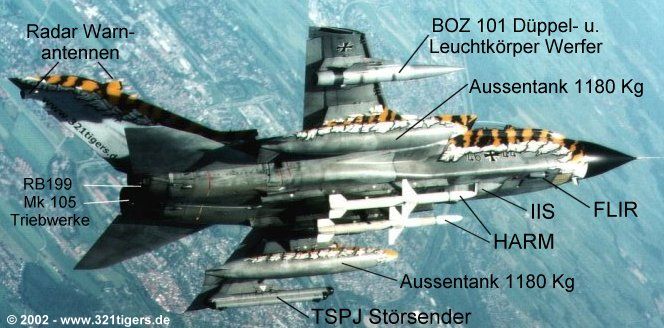
You find the following systems, partially with different names, in every modern airplane, especially in the civillian ones. In the sum of it and in their interoperation you define the complexity of the whole system. For nearly every of those systems there is in the wing an own shop with specialists, a toolshop which does nothing else but take care of this system or aircraft part.
| ADC | Air Data Computer | Does together with the pitot tube in the nose of the aircraft speed computations. Static and dynamic air pressure, air temperature and moisture are needed for that. Output is the aircraft speed KIAS and KCAS. Those values are feeded into the main computer. |
| AFDS | Automatic Flight Director System | The Auto-Pilot. |
| CSAS | Command Stability and Augmentation System | Steering and damping system (-> fly-by-wire) |
| DECU | Digital Engine Control Unit | Translates throttle movements into signals for the engines depending on parameters like outside temperature, altitude, speed and angle of attack. |
| DOPPLER | Doppler Radar | Measures and delivers speed abouve ground and drift to the main computer as so called short term values. |
| GMR | Ground Mapping Radar | Radar for navigation with ground references |
| GPS | Global Positioning System | Not available until the Balkan wars when it was introduced to the rear cockpit as a standalone unit on top of the central radar display. In latest versions integrated into a modern laser-IN (innertial navigator). |
| HF | HF radio | shortwave radio for worldwide communication under ideal atmospherical conditions (and for radio reception) |
| HUD | Head up display | For important data shown to the pilot in the front screen. |
| IFF | Identification Friend-Foe | Radiates encrypted codes to get identified as a friend from the ground and from fighter aircraft. Has to be triggered by those stations. |
| IN | Innertial Navigator | A gimbal platform which measures accelerations along the three axis of an airplane and uses this data for speed, direction and position determination. One of the most important systems on board. Delivers long term data to the main computer for navigation. Takes over full navigation in case of a main computer failure. |
| MC | Main Computer | Central computer unit. Collects data from all systems and sub-systems for navigation, operation of other sub-systems like the radar and for weapon computations |
| MCS | Missile Control System | Operates all HARM missile functions except launch and emergency drop. |
| NSAS | Nosewheel stabilization and augmentation system | Dampens, stabilizes and augments the nosewheel steering especially during thrust reverser operations after landing when the aircraft tends to break off to a side. |
| RAD ALT | Radar Altimeter | Provides the altitude above ground up to 5000 ft. Data is supplied to the main computer MC. |
| SAHR | Secondary Attitude and Heading Reference System | A gimbal platform to determine the position of the airplane in the air. Supplies its data to the main computer MC. A redundancy system to the IN. |
| SMS | Storage Management System | In charge for the management of all kinds of outside stores, like tanks, refuelling devices, missiles, bombs etc. etc.including the canons. |
| TACAN | Tactical Air Navigation System | It provides the user with bearing and distance (slant-range or hypotenuse) to a ground or ship-borne station. It is a more accurate version of the VOR/DME system that provides bearing and range information for civil aviation. |
| TFR | Terrain Following Radar | Makes it possible to fly under aller weather conditions, day and night, highspeed at very low altitures and automatically avoid any terrain or obstacle. |
| V/UHF | Radio for VHF and UHF bands. | |
| Weitere wichtige Systeme und Anlagen: | Bordenergieversorgungsanlage, Klima- u. Abzapfluftanlage, Bordsauerstoffanlage, Bewaffnungsanlage, Fanghakenanlage, Kraftstoffanlage, Hydraulikanlage, Feuerlöschanlage, Rettungssystemanlage, Triebwerkregelanlage, Hilfsantriebsanlage, Flugschreiberanlage, Druckluftanlage, Autothrottle Anlage usw. | |
 The ejection seat of the Tornado
The ejection seat of the Tornado No other system or sub-system of a military jet gives a larger appeal to the non-professional like the ejection seat. This is because its nifty technics and construction safes the lifes of the crews in already dangerous peacetime flying but much more spectacular during wartime like proven a couple of thousand times in the past. It presents itself impressively with lots of grips, levers, bolts gartes, tubes, electrical lines etc etc. to everybody who had once the chance to get a view into the cockpit of an operational jet.
Performance parameters of the Martin Baker Mk-10 (a safe ejection is guaranteed at:):
One second reaction time is always included into the activation time.
Correctly put on straps and observing the minimum parameters at activation as well as the correct upright positioning of the pilot on the seat is absolutely necessary to survive the ejection without heavy injuries. Not obeying this nearly always leads - because of the short but powerful accelleration - to hurting or breaking the spine near the neck. Arms and legs are being pulled back to the body automatically by the blue straps to avoid flailing of them in the heavy airstream. The seat is activated by pulling a loop between the legs which makes it difficult to keep in mind to keep the body upright. Older versions of the seat, e.g. in the F-104 Starfighter, had a second grip to pull above the head. When pulling this grip a piece of fabric was pulled over the head to push it back for an upright body and to protect helmet and face from the airstream.
To avoid heavy injuries of the extremities has this seat a pull-back mechanism for arms and legs. The legs have to be pulled out from under the instrument panel otherwise they would be cut of throug it. Arms are pulled between the legs to avoid flailing in the airstream which could at very high speeds rip them of the body. Arms and legs are released when the seat-man separation takes place automatically.
To avoid the lack of oxygen and heavy brain damges by this, when exiting in high altitudes and during the fall, which can take up to 5 minutes, the seat is equipped with an oxygen bottle which delivers oxygen into the pilots mask for up to 5 minutes.
To avoid that the pilot spents half an hour or longer on his parachute in high altitudes and suffers from hypothermia or dies from the lack of oxigen, the seat is equipped with a barostat. This initiates a seat-man separation earliest when the falling pilot passes through 5000 meter.
The whole ejection sequence happens after initiation completely automatically. Only the seat-man separation can be forced by means of a lever. To avoid collission with the canopy a detonation chord in the canopy top explodes on activation and destroys it.
Schematic sequence of an ejection seat activation
Im zwei-Mann Cockpit des Tornado stellt sich der Ausschuß etwas komplizierter dar, als in einem ein-Mann Cockpit. Über einen Hebel im hintern Cockpit kann eingestellt werden, ob nach einer Auslösung durch den WSO beide, oder nur der WSO ausgeschossen werden. Im allgemeinen wird dieses Ventil auf Doppelausschuss gestellt. Hierdurch wird immer - egal wer auslöst - der WSO ausgeschossen und 0,2 Sekunden später der Pilot.
Die Martin Baker Seite zum Mk 10 Schleudersitz:
https://martin-baker.com/products/mk10-ejection-seat/
The efectiveness of a weapon system depends a lot on its on survivability which means how well you can protect yourself from an adversary. For this purpose the TORNADO has a bunch of systems which serve its survivability.
All TORNADOs are equipped with the ERWE (Enhanced Radar Warning Equipment). This system belongs to the RWRs (Radar Warning Receiver) and is a tool comprised of antennas to detect electromagnetic energy especially the one radiated from radars. The beams are analysed and matched aganist data from a computer library. Depending of the state of the threat and the phase he is in, a symbol is generated and shown on a display. Additionally a specific sound is given which which the crew can identify a threat without having to look on the display. The develpment of these systems began alreade during WW II.
To successfuly counteract radar tracking or a shot at you you first have to recognize that you are threatened and by what or whom.
 This
is relatively ease with counter-air systems which use radar, either for
rangeing or tracking or missile controlling. This electrical energy can be
sensed and the azimuth determined and analysed by whole bunch of parameters.
For this purpose all modern fighter jets but also helicopters and even
transport aircraft have a so called radar warning receiver (RWR), also some
cars ;-). The system of the TORNADO is named ERWE (Enhanced
Radar Warning Equipment). It analyses radarbeams for pulslength, pulswidth,
pulsfrequency pulsrepetition frequency and so on and compares these
parameters to an emitter library (ELIB) with known radar data. When the
comparison was successful a corresponding symbol with another symbol around
it which gives more information is given on the ERWE display. Additionally a
unique tone or sequence of tones is given into the headphones so that the
crew gets a heads-up that something important is happening. In case several
threats come up at the same time they are sorted according priorities and
given a so called enhancement symbol around it.
This
is relatively ease with counter-air systems which use radar, either for
rangeing or tracking or missile controlling. This electrical energy can be
sensed and the azimuth determined and analysed by whole bunch of parameters.
For this purpose all modern fighter jets but also helicopters and even
transport aircraft have a so called radar warning receiver (RWR), also some
cars ;-). The system of the TORNADO is named ERWE (Enhanced
Radar Warning Equipment). It analyses radarbeams for pulslength, pulswidth,
pulsfrequency pulsrepetition frequency and so on and compares these
parameters to an emitter library (ELIB) with known radar data. When the
comparison was successful a corresponding symbol with another symbol around
it which gives more information is given on the ERWE display. Additionally a
unique tone or sequence of tones is given into the headphones so that the
crew gets a heads-up that something important is happening. In case several
threats come up at the same time they are sorted according priorities and
given a so called enhancement symbol around it.
Nearly impossible is the recognition of shoulder based anti-air systems like Stinger, SA-7, 14, 16 ... Their shooters look visually for targets. When aquired the infrared search head locks onto a heat source (mainly the engine exhaust) of the aircraft. The crew has to visually recognize the lauch of such a missile and try to avoid it by manouvering accompanied by the deployment of anti-heat seaker decoys, so called flares. Normally this is already done when you expect a threat at a specific point without trying ot aquire visually.
Possible but with the lowest chance of survival is the visual aquiring of a missile lauch or the observation of its approach. The crew has only splits of seconds for a suitable reaction.
 Visual
aquiration of a missile launch during the 2nd golf war.
Visual
aquiration of a missile launch during the 2nd golf war.
An Iraqi truck-mounted, surface-to-air missile, believed to be an upgraded SA-3, tracks and then fires on a coalition aircraft in July. These still photographs are from a videotape of the encounter made from aircraft. Chairman of the Joint Chiefs of Staff Gen Richard B. Myers, USAF, showed the videotape during a news briefing with Secretary of Defense Donald H. Rumsfeld in the Pentagon on September 30, 2002. DoD photos
When the crew has luckily detected a threat she quickly has to react propperly. Without losing too much time the crew has - depending on phase of the attack, weather, visibiliy, altitude, speed, position, terrain, task, position of own forces etc. - to apply mostly one or a combination of the following meassures: run, defeat by manourvering, manourvering as a team if in formation, electronic countermeasures and so on.
On both outside station the TORNADO carries systems for self-defense. On the right side BOZ-101 which carries chaff and flares. Chaff, which is made of tiny aluminum stripes, is applied against radar and flares which burn very strong after deployment to attrackt heat seeker missiles. On the left side the ECM pod Cerberus III, later TSPJ (Tornado self protect jammer) which jams and/or destracts radar systems. Meanwhile both systems have been substituted by modernized systems.

The prominent, missile like looking container, contains between begin of the pointed tip and the dark ring at the end which opens ca. 150 Kg of coated aluminum on a long roll. The aluminum is cut into little dipols by a rotating knife and deployed through the opening at the end. The lengths of the depoles correspond with subsets of wavelengts used in electronic combat. The airstream opens the thousands of dipols into a big cloud. Since the little antennas reflect the radar beam better than the real aircraft the tracking radar beam is immediately distracted onto this cloud and in an ideal case the tracking is broken. This makes it impossible to lunch the missile or steer it into the target.

 The
cylinder behind the chaff is filled with flares against search heads of infrared
trackers/missiles. These flares burn for 6-7 seconds with a very bright light
and simulate the light- and temperature spectrum of an jet engine but with
higher intensity so that an approaching heat seeker missile loses sight on the
aircraft and locks on to the flare. While this is happening the aircraft must
try to escape with hard manouvering. This was the good message. The bad one is,
that modern missiles recognize flares and "closes the eye". After some seconds
they continue the chase. With a skillful application of sets of flares and
manouvering in short sequence it is possible for the aircraft to defeat the
missile nevertheless. The possible combinations of chaff and flare application
are stored in a library in the BOZ and can be initiated with pushbuttons by the
WSO.(images: luftwaffe.de)
The
cylinder behind the chaff is filled with flares against search heads of infrared
trackers/missiles. These flares burn for 6-7 seconds with a very bright light
and simulate the light- and temperature spectrum of an jet engine but with
higher intensity so that an approaching heat seeker missile loses sight on the
aircraft and locks on to the flare. While this is happening the aircraft must
try to escape with hard manouvering. This was the good message. The bad one is,
that modern missiles recognize flares and "closes the eye". After some seconds
they continue the chase. With a skillful application of sets of flares and
manouvering in short sequence it is possible for the aircraft to defeat the
missile nevertheless. The possible combinations of chaff and flare application
are stored in a library in the BOZ and can be initiated with pushbuttons by the
WSO.(images: luftwaffe.de)
TSPJ (TORNADO Self Protection Jammer, successor of Cerberus III):
The possibilities of an electronic jammer are so widespread (and sooo secret)
that only a small overview is possible. Check the internet for deeper going
information!
The best know and oldest jamming technique is range jamming as
well as angular jamming of the threat radar. For a description of those methods
see Wikipedia!
The TORNADO as well as all other fighter jets (only exception the RF-4 in former times) carry offensive weapons to carry out a task and defensive weapons for self defense. For air-to-air fighters offensive and defensive weapons are identical for obvious reasons because their task is to fight fighters.
For self defense the TORNADO can carry up to four AIM-9 (Sidewinder) infrared guided air-to-air missiles. Besides the TORNADO many other fighter jets carry this US made weapon. It was an is for many years the standart IR air-to-air missile within NATO and was already during the Vietnam War in use. As a successor the german TORNADOs are meanwhile equipped with IRIS-T, a european cooperation project. Meanwhile, 2023 the land based version of IRIS-T proved to be very effective in the Ukrainian War of the ruZZian aggressors.
AIM-9 additional information:
Sketch of the missile:
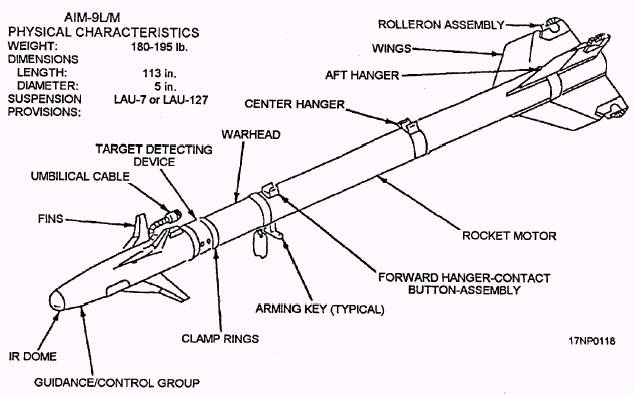

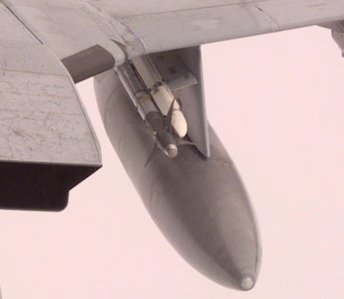
2. HARM AGM-88 as offensive weapon
The HARM (High Speed Anti Radiation Missile) is the main offensive weapon of the TORNADO ECR. Meanwhile (2023), because of the ASSTA upgrades of the TORNADO fleet, every TORNADO can carry every kind of offensive weapon available to TORNADO. Nevertheless, with its unique ELS (Emitter Locator System) the ECR can apply the HARM missile most effectively.

During the Vietnam War America's air superiority was suddenly endangered with the newly introduced sowjet SAMs into the theatre of war and those Surface-to-Air missiles inflicted significant losses to the Americans. As a reaction the developement of a so called "Anti-Radar-Missle" ARM started. Finally two different systems were introduced: the "Shrike" was a relative cheap and simple variant who's capabilities were rather small because of its limited frequency range, the little range and the bad precission. Another developement created the "Standard ARM", a more sophisticated missile. Because of its bad reliability and its high price, only a small nuber was build.
Because of this the request came up to construct a cheaper version of Shrike, initially called "Super Shrike". It should have a larger range and a better precission and a search head suitable for a cheap mass production and capable to detect all known radar frequencies. The developement took a couple of years and after countless improvements because of user requests (extended frequency range, flexible steering logic, etc. etc.) Texas Instruments finally presented the HARM AGM-88A. This missile was introduced to USAF und US Navy in high numbers. The first operational use took place 1986 in the attack of Libya and finally proved the great effectiveness of the missile.
Strichzeichnung der HARM:
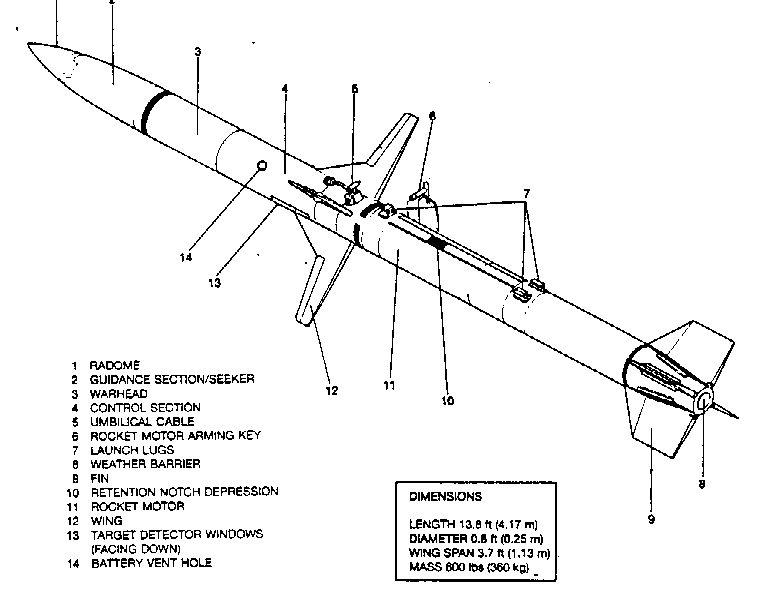
The german Luftwaffe decided to introduce and integrate AGM 88B Block 2 which proved its effectiveness in the Kosovo conflict. With the ASSTA upgrades of the TORNADO also newer and more modern versions of the HARM were integrated into the weapon system.

BTW the colored rings around the missile have a meaning. Blue means that this is a training missile with a working seeker head but without rocket motor and warhead. The space is filled with weights so that the behaviour in flight remains as for a life missile. If the ring is golden then its an armoured operational missile.
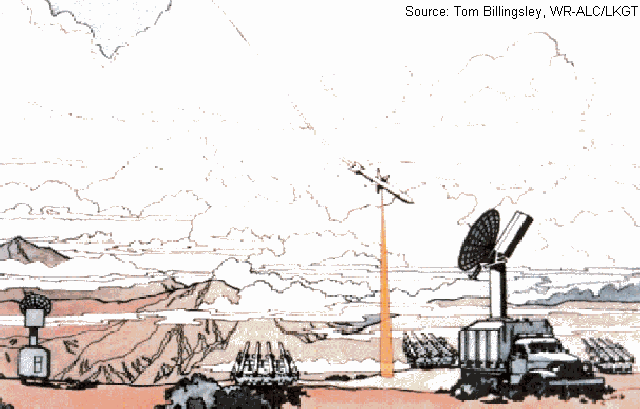
A repair of the radar will not be to discussion in most cases .. .
The ELS is the main sensor of the ECR for detection, identification, location and suppression of RADAR based anti-air systems. Although the HARM missile with its sensitive seeker head and sophisticated electronics is also capable to find and identify and partialy locate radars, the ELS performs far bejond this with its two specialized antenna arrays in the wing roots (former position of the Krüger flaps). Through triangulation while passing by the position of a radar can be determined in a split second to within a couple of meters. Also in seconds the position is handed over to HARM prior launch..
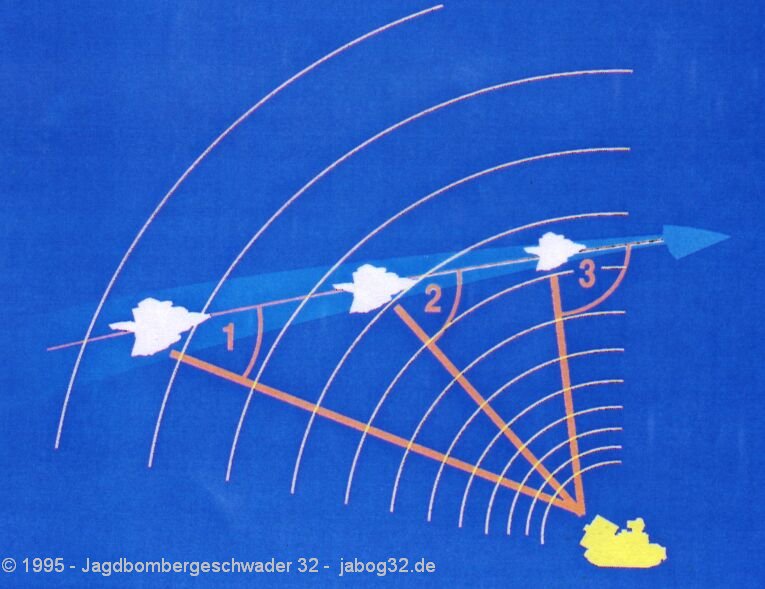
The longer signals are cought (dozens of systems can be handled at the same time) the better is the rangeing and analysis and display on the monitors. A depression starts with marking the system on the display by the WSO. With start of the attack all necessary data from the Libraries and the ELS are transfered to the HARM missile.
After the lauch the missile flies first just into the direction of the target without trying to get a lock itself. When the missile passes on its way a specific point in space, the so called trip-point, it opens its eyes and looks for the target at the given position and a defined area around it. This is done to avoid that the missile goes for a wrong target and not the designated. When the target is switched off the missile opens its eyes wider and depending on the programming goes for another system of the same type or goes for any other definded type in the defined target area. Newer versions of HARM hit with the help of GPS the given position anyways. All options and modes of HARM are programmed prior flight by the crew together with the EW officer.
The attack description from above describes a so called "planed attack". Beside this there are a couple of other attack modes like e.g. "Target of Opportunity" TOO or the "Self Defense Attack", which basically corresponds to a duel situation like in the Wildwest. Further attack modes cannot be discussed here.
In preparation
FLIR (Forward looking Infrared)
IIS (Infrared Imaging System)
ODIN (Operational Data Interface)
![]() © www.321tigers.de - Impress - Privacy Notice
© www.321tigers.de - Impress - Privacy Notice